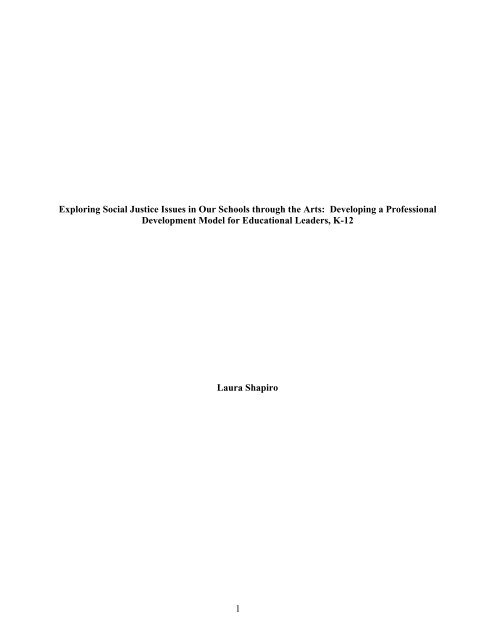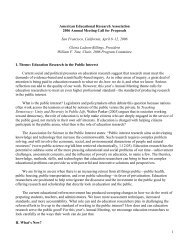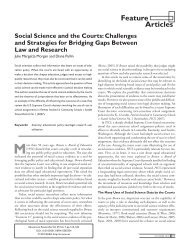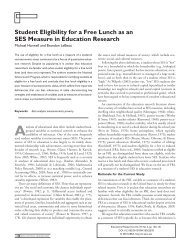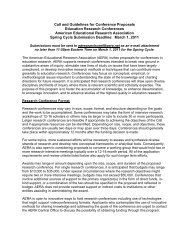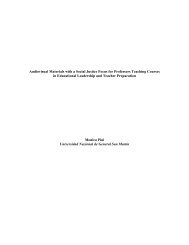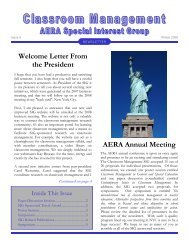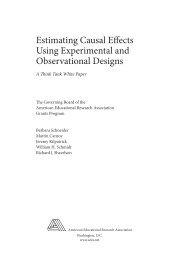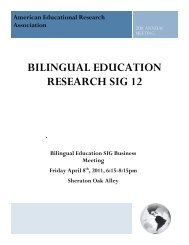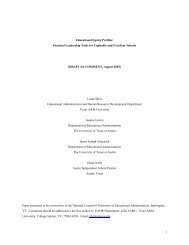1 Exploring Social Justice Issues in Our Schools through the Arts ...
1 Exploring Social Justice Issues in Our Schools through the Arts ...
1 Exploring Social Justice Issues in Our Schools through the Arts ...
Create successful ePaper yourself
Turn your PDF publications into a flip-book with our unique Google optimized e-Paper software.
<strong>Explor<strong>in</strong>g</strong> <strong>Social</strong> <strong>Justice</strong> <strong>Issues</strong> <strong>in</strong> <strong>Our</strong> <strong>Schools</strong> <strong>through</strong> <strong>the</strong> <strong>Arts</strong>: Develop<strong>in</strong>g a Professional<br />
Development Model for Educational Leaders, K-12<br />
Laura Shapiro<br />
1
<strong>Explor<strong>in</strong>g</strong> <strong>Social</strong> <strong>Justice</strong> <strong>Issues</strong> <strong>in</strong> <strong>Our</strong> <strong>Schools</strong> <strong>through</strong> <strong>the</strong> <strong>Arts</strong>:<br />
Develop<strong>in</strong>g a Professional Development Model for Educational Leaders, K-12<br />
1. Introduction:<br />
Laura Shapiro<br />
The grant provided partial support for <strong>the</strong> summer retreat, July 16- 18, for women<br />
adm<strong>in</strong>istrators, "<strong>Explor<strong>in</strong>g</strong> <strong>Social</strong> <strong>Justice</strong> <strong>Issues</strong> <strong>in</strong> <strong>Our</strong> <strong>Schools</strong> Through <strong>the</strong> <strong>Arts</strong>". The retreat<br />
was one of three retreats that I am conduct<strong>in</strong>g as part of my doctoral research. The first retreat<br />
was April 20 and 21, 2002 and <strong>the</strong> last retreat will be November 16 and 17, 2002. My doctoral<br />
work, a qualitative study based on <strong>the</strong> retreats, is designed to <strong>in</strong>vestigate <strong>the</strong> follow<strong>in</strong>g primary<br />
question.<br />
What is unique and <strong>in</strong>terest<strong>in</strong>g about <strong>the</strong> artmak<strong>in</strong>g process as a significant component of a<br />
professional development experience and as a way for women public school adm<strong>in</strong>istrators to<br />
explore social <strong>in</strong>justice issues <strong>in</strong> our schools? As a way for us to explore our different cultural<br />
and power perspectives as women adm<strong>in</strong>istrators?<br />
Related questions are :<br />
What does <strong>the</strong> group's art work tell us? Can <strong>the</strong> artwork stand alone?<br />
How might we improve <strong>the</strong> quality of our artwork for greatest effectiveness as works of art?<br />
If we make art, does that make us artists? Do we have a right to show our work? Does <strong>the</strong> art<br />
work and experience suffer if some of us are formally tra<strong>in</strong>ed as artists and o<strong>the</strong>rs are not?<br />
What difference has <strong>the</strong> artmak<strong>in</strong>g process made <strong>in</strong> how we act as women adm<strong>in</strong>istrators<br />
concerned about social justice issues? Does participation <strong>in</strong> this artmak<strong>in</strong>g professional<br />
development process give us courage and <strong>the</strong> tools to make change <strong>in</strong> practice?<br />
What happens if we share our artwork with o<strong>the</strong>r women adm<strong>in</strong>istrators? Do we experience<br />
resistance do we have to shar<strong>in</strong>g our work <strong>in</strong> public? If so, what does this resistance tell us?<br />
What does this resistance tell us? If so, how and what? How do our audiences respond to our art<br />
works?<br />
How might we transfer this way of learn<strong>in</strong>g to o<strong>the</strong>r adm<strong>in</strong>istrators? To teachers? To<br />
parents? If so, how?<br />
2
2. Overview of Accomplishments:<br />
a. The summer retreat was held July 16, 17 and 18 <strong>in</strong> West Park, New York.<br />
b. All twelve women adm<strong>in</strong>istrators participants <strong>in</strong> <strong>the</strong> project attended, although 2 of <strong>the</strong><br />
women came for only one day. The two women did not stay overnight with <strong>the</strong> rest of <strong>the</strong> group.<br />
c. Kwardua Vanderpuye and Lucy Barbera, co-facilitated <strong>the</strong> sessions with me. Dur<strong>in</strong>g <strong>the</strong> first<br />
two days of <strong>the</strong> retreat we focused on Theatre of <strong>the</strong> Oppressed as our primary strategy. Dur<strong>in</strong>g<br />
<strong>the</strong> third day we used visual journal<strong>in</strong>g and mask mak<strong>in</strong>g as <strong>the</strong> primary strategies. Dur<strong>in</strong>g <strong>the</strong><br />
even<strong>in</strong>gs several of <strong>the</strong> participants participated <strong>in</strong> <strong>in</strong>formal discussions concern<strong>in</strong>g social justice<br />
issues <strong>in</strong> our schools.<br />
d. I documented <strong>the</strong> retreats with video, audio tape and digital photos. I wrote field notes<br />
dur<strong>in</strong>g and follow<strong>in</strong>g <strong>the</strong> retreat. I collected <strong>the</strong> visual journals and sent color copies of <strong>the</strong> work<br />
to each participant follow<strong>in</strong>g <strong>the</strong> retreat. Participants took <strong>the</strong>ir masks with <strong>the</strong>m. I photographed<br />
<strong>the</strong> masks and collected any writ<strong>in</strong>g that was produced.<br />
3. Description of <strong>the</strong> professional development strategies used dur<strong>in</strong>g <strong>the</strong> summer retreat.<br />
a. Retreat Sett<strong>in</strong>g:<br />
The retreat was held at <strong>the</strong> Holy Cross Monastery, Port Ewen, New York, <strong>in</strong> <strong>the</strong> Mid- Hudson<br />
Valley, near where I live, and with<strong>in</strong> a two to three hour drive for <strong>the</strong> participants. The<br />
monastery is set overlook<strong>in</strong>g <strong>the</strong> Hudson River and <strong>the</strong> Catskill mounta<strong>in</strong>s.. The monastery is<br />
filled with comfortable antique furnish<strong>in</strong>gs and has a light filled d<strong>in</strong><strong>in</strong>g room that overlooks <strong>the</strong><br />
river. There are walk<strong>in</strong>g paths and porches for contemplation. I asked each participant for her<br />
approval before I committed to <strong>the</strong> monastery. Although our work would not <strong>in</strong>volved religion,<br />
<strong>the</strong> religious sett<strong>in</strong>g could potentially have an impact on our work. All gave <strong>the</strong>ir approval and<br />
we took time dur<strong>in</strong>g <strong>the</strong> retreat to discuss <strong>the</strong> impact of be<strong>in</strong>g at a monastery. I carefully selected<br />
this sett<strong>in</strong>g for our retreat. Women adm<strong>in</strong>istrators are under a tremendous anount of stress and<br />
little time for reflection, specifically time to reflect with a supportive group. This was expressed<br />
by each adm<strong>in</strong>istrator dur<strong>in</strong>g my <strong>in</strong>itial <strong>in</strong>take <strong>in</strong>terviews. In response to <strong>the</strong>ir need for some<br />
time to rejuvenate, I selected a sett<strong>in</strong>g that would nurture <strong>the</strong>m. I purposely titled my <strong>the</strong> project,<br />
3
"retreat"; my hypo<strong>the</strong>sis was that that ano<strong>the</strong>r "workshop" would be deplet<strong>in</strong>g and not attractive<br />
to very busy educational leaders. The gorgeous, quiet sett<strong>in</strong>g helped participants to relax, focus,<br />
and to heighten <strong>the</strong>ir awareness of <strong>the</strong>ir senses. These elements, accord<strong>in</strong>g to <strong>the</strong> participants,<br />
were important factors <strong>in</strong> enhanc<strong>in</strong>g <strong>the</strong> process of engag<strong>in</strong>g with artmak<strong>in</strong>g, each o<strong>the</strong>r and <strong>the</strong><br />
issues at hand.<br />
Each of <strong>the</strong> participants agreed to stay overnight at <strong>the</strong> monastery for two nights. All but two<br />
women stayed. The time toge<strong>the</strong>r allowed participants <strong>in</strong>formal time to be alone, toge<strong>the</strong>r <strong>in</strong><br />
small groups and time to work <strong>in</strong> <strong>the</strong> studio. Mak<strong>in</strong>g time to be away from school was important;<br />
<strong>the</strong> two women who did not stay over or participate <strong>in</strong> significant parts of <strong>the</strong> retreat, were local<br />
and had access to <strong>the</strong>ir schools. They were unable to pull <strong>the</strong>mselves away. I will be address<strong>in</strong>g<br />
this issue <strong>in</strong> my dissertation.<br />
Lucy Barbera , my co-facilitator and I, carefully set up an art studio space <strong>in</strong> <strong>the</strong> monastery.<br />
The room was air-conditioned and light. We set out materials on tables so that <strong>the</strong>y were<br />
available and attractive. Materials were set out on tables covered with white butcher paper to<br />
enhance <strong>the</strong> texture and color of <strong>the</strong> materials. We used <strong>the</strong> studio dur<strong>in</strong>g structured activities<br />
and it was open 24 hrs. a day for <strong>the</strong> participants' use. Some of <strong>the</strong> women chose to work <strong>in</strong> <strong>the</strong><br />
studio dur<strong>in</strong>g <strong>the</strong> even<strong>in</strong>gs or early morn<strong>in</strong>g. Lucy brought a variety of CD's and music was<br />
played at various times <strong>in</strong> <strong>the</strong> studio. In addition to <strong>the</strong> studio room, <strong>the</strong>re was a lovely liv<strong>in</strong>g<br />
room available to us for group discussions and our Theatre of <strong>the</strong> Oppressed work. At times, we<br />
worked outside on <strong>the</strong> lawn, overlook<strong>in</strong>g <strong>the</strong> river. The participants were enchanted by <strong>the</strong><br />
sett<strong>in</strong>g and thanked me for br<strong>in</strong>g<strong>in</strong>g <strong>the</strong>m <strong>the</strong>re. The cost to participants to stay at <strong>the</strong> monastery<br />
was relatively <strong>in</strong>expensive.<br />
Dur<strong>in</strong>g <strong>the</strong> retreat, we discussed <strong>the</strong> school environments <strong>in</strong> which we worked and how <strong>the</strong>y<br />
might be transformed <strong>in</strong>to more welcom<strong>in</strong>g, aes<strong>the</strong>tic places to establish creative, just learn<strong>in</strong>g<br />
environments. Several participants shared that <strong>the</strong>y had, over central office objections, pa<strong>in</strong>ted<br />
<strong>the</strong>ir halls and offices <strong>in</strong> a way that was more welcom<strong>in</strong>g. School environments are often<br />
oppressive and <strong>the</strong> focus of considerable power struggles. Hav<strong>in</strong>g had this experience at <strong>the</strong><br />
monastery, one of <strong>the</strong> retreat participants decided to take her staff on a retreat to a country sett<strong>in</strong>g<br />
this fall.<br />
4
. My Role:<br />
Dur<strong>in</strong>g <strong>the</strong> summer retreat, I functioned as an adm<strong>in</strong>istrator, co-facilitator, researcher and<br />
occasional participant. I adm<strong>in</strong>istered <strong>the</strong> arrangements with <strong>the</strong> monastery, made sure<br />
participants had transportation connections, and paid <strong>the</strong> bills. Much of my co-facililat<strong>in</strong>g was<br />
dur<strong>in</strong>g <strong>the</strong> plann<strong>in</strong>g phases and dur<strong>in</strong>g times when a decision needed to be made concern<strong>in</strong>g <strong>the</strong><br />
changes <strong>in</strong> our plan. I also refocused <strong>the</strong> group and provided overviews of each day. I allowed<br />
Kwardua to take <strong>the</strong> lead on <strong>the</strong> Theatre of <strong>the</strong> Oppressed, her expertise, and Lucy on <strong>the</strong> mask<br />
mak<strong>in</strong>g and movement sections. I took <strong>the</strong> lead on <strong>the</strong> visual journal<strong>in</strong>g and writ<strong>in</strong>g<br />
components, areas of my strength. I decided to let my co-facilitators take <strong>the</strong> lead dur<strong>in</strong>g most of<br />
<strong>the</strong> retreat so that I could focus more on my role as researcher. I took notes and observed . At<br />
times, dur<strong>in</strong>g several of <strong>the</strong> Theatre of <strong>the</strong> Oppressed, <strong>the</strong> movement activities, I participated<br />
with <strong>the</strong> group; I found that without participat<strong>in</strong>g <strong>in</strong> <strong>the</strong> art experience, I was not as <strong>in</strong> touch with<br />
<strong>the</strong> pulse of <strong>the</strong> group as I would have liked. By participat<strong>in</strong>g at times, I felt more <strong>in</strong> touch and<br />
could make more <strong>in</strong>formed decisions about what needed to happen next. As a former school<br />
adm<strong>in</strong>istrator, I also contributed my experiences with <strong>the</strong> group as a way to raise questions and<br />
empathize with <strong>the</strong>ir experiences. This blend of roles worked well. Prior to <strong>the</strong> retreat I <strong>in</strong>vited<br />
<strong>the</strong> participants to suggest and/or facilitate activities for even<strong>in</strong>g sessions and as "light and lively<br />
" activities. I suggested that perhaps small groups might want to discuss <strong>in</strong> more depth, some of<br />
<strong>the</strong> topics that were raised by <strong>the</strong> group, <strong>in</strong>clud<strong>in</strong>g homophobia <strong>in</strong> schools, nepotism or share a<br />
video concern<strong>in</strong>g social justice <strong>in</strong> schools. One woman volunteered to lead a drumm<strong>in</strong>g circle,<br />
which we <strong>in</strong>corporated <strong>in</strong>to <strong>the</strong> program. Dur<strong>in</strong>g <strong>the</strong> even<strong>in</strong>g times, I was more of a participant<br />
and researcher than facilitator.<br />
c Schedule: <strong>Our</strong> schedule for each day of <strong>the</strong> retreat was as follows:<br />
8:30 - 9 Welcome, coffee and muff<strong>in</strong>s<br />
9- 12:30 Workshop<br />
12:30 - 1:15 - lunch<br />
1:30 - 4:00 : workshop<br />
4- 6 - break/ studio/ rest<br />
5
6- 7 : d<strong>in</strong>ner<br />
7- 9 : optional discussion/ studio<br />
<strong>Our</strong> schedule varied slightly each day, depend<strong>in</strong>g on <strong>the</strong> needs of our group. The facilitators<br />
negotiated any changes <strong>in</strong> <strong>the</strong> schedule with <strong>the</strong> group. Each day built upon <strong>the</strong> issues and<br />
feel<strong>in</strong>gs raised dur<strong>in</strong>g <strong>the</strong> previous day. Prior to <strong>the</strong> summer retreat , I conducted several<br />
plann<strong>in</strong>g sessions with each of my co-facilitators. <strong>Our</strong> plans were used as a framework and were<br />
modified as <strong>the</strong> group needed. It was important for me to ma<strong>in</strong>ta<strong>in</strong> <strong>the</strong> group's focus on our<br />
purpose and <strong>the</strong> purpose of my research. The group bonded considerably dur<strong>in</strong>g <strong>the</strong> spr<strong>in</strong>g<br />
retreat and at times, I needed to refocus <strong>the</strong> group; some participants wanted to engage <strong>in</strong> side<br />
conversations and unfocused discussions. There was little resistance from <strong>the</strong> group to my<br />
attempts to refocus. They seemed amenable s<strong>in</strong>ce <strong>the</strong>re was ample time for such discussions <strong>in</strong><br />
<strong>the</strong> even<strong>in</strong>g and dur<strong>in</strong>g breaks.<br />
d. Specific Professional Development Strategies Implemented:<br />
Day 1, July 16<br />
Morn<strong>in</strong>g:<br />
• Name tags, work<strong>in</strong>g on prompts on <strong>the</strong> flip charts<br />
• Introduction<br />
• Breath<strong>in</strong>g<br />
• Free write: Someth<strong>in</strong>g significant that happened s<strong>in</strong>ce last retreat <strong>in</strong> your role as an<br />
educational leader work<strong>in</strong>g on social justice issues <strong>in</strong> your school.<br />
• Round rob<strong>in</strong> shar<strong>in</strong>g of po<strong>in</strong>ts from <strong>the</strong> writ<strong>in</strong>g<br />
Lunch<br />
• Theatre of <strong>the</strong> Oppressed<br />
o Name game with sound and gesture<br />
o Mach<strong>in</strong>es<br />
o Mach<strong>in</strong>e of school, reflection<br />
o Bl<strong>in</strong>d series<br />
o Play with <strong>the</strong> object, pass <strong>the</strong> object<br />
o Group knot<br />
Afternoon:<br />
• Mirror l<strong>in</strong>e<br />
• Mask of <strong>the</strong> Oppressor, make <strong>the</strong> eyes of <strong>the</strong> oppressor, <strong>the</strong> mouth, gesture, one work<br />
he/she would say, etc<br />
• Image of Oppression/ tableau demonstration<br />
6
• Debrief<strong>in</strong>g<br />
• Movement with scarves to music<br />
• Reflection<br />
• Orientation to visual journals<br />
4-6 free time<br />
D<strong>in</strong>ner<br />
Even<strong>in</strong>g:<br />
• Shar<strong>in</strong>g of photos that we brought from school and discussion<br />
DAY 2: July 17<br />
Morn<strong>in</strong>g:<br />
• Theatre of <strong>the</strong> Oppressed , cont<strong>in</strong>ued<br />
• Check <strong>in</strong>: How are we feel<strong>in</strong>g now about yesterday? ( <strong>in</strong> pairs and <strong>the</strong>n whole group)<br />
• Human Race (on <strong>the</strong> hill) with discussion<br />
• Visual journal<strong>in</strong>g<br />
• Wheel Exercise:<br />
o Fear and It’s Opposite / creat<strong>in</strong>g body masks/<strong>in</strong>ternal , <strong>the</strong>n external<br />
monologues, <strong>the</strong>n dialogs, view<strong>in</strong>g each<br />
• Revelations: In pairs, create a scene. In your role as a educational leader play a current<br />
situation <strong>in</strong> which you each have a secret that is revealed <strong>in</strong> <strong>the</strong> dialog<br />
Lunch<br />
Afternoon:<br />
• Choos<strong>in</strong>g a story to tell that resonates with <strong>the</strong> group. People volunteer to tell about a<br />
conflict <strong>in</strong> which <strong>the</strong>y are experienc<strong>in</strong>g <strong>in</strong> school that is unresolved, you are <strong>the</strong><br />
protagonist and <strong>the</strong>re is a specific antagonist.<br />
• Vot<strong>in</strong>g on which scene to play before <strong>the</strong> group<br />
• Play<strong>in</strong>g out one situation “Censorship/closed communication”<br />
• Lighten<strong>in</strong>g Forum: People take protagonist's place to show possible alternative ways to<br />
get what she wants.<br />
• Reflection<br />
Even<strong>in</strong>g session options:<br />
• Open studio<br />
• Rest<strong>in</strong>g<br />
• Discussion<br />
7
DAY 3: July 18<br />
Morn<strong>in</strong>g:<br />
• Check <strong>in</strong><br />
• Drumm<strong>in</strong>g<br />
• Options for <strong>the</strong> morn<strong>in</strong>g: Can move to o<strong>the</strong>r forms. Creative connection.<br />
o Write about an oppressive situation you are <strong>in</strong> as an educational leader. (Similar<br />
to <strong>the</strong> skit pairs). Use creative non-fiction techniques. You are <strong>the</strong> protagonist and<br />
<strong>the</strong>re is a specific antagonist.<br />
o The rehearsal<br />
o Then, write about <strong>the</strong> dialog you imag<strong>in</strong>e with <strong>the</strong> antagonist. What do you say?<br />
What do you do? What do you imag<strong>in</strong>e will happen / what <strong>the</strong> antagonist will say<br />
or do? Then what? What will you <strong>the</strong>n say or do to get what you want?<br />
• 2-D Visual Journal<strong>in</strong>g:<br />
o Same th<strong>in</strong>g but visualize or comb<strong>in</strong>e <strong>the</strong> writ<strong>in</strong>g and <strong>the</strong> images<br />
o Or take a <strong>the</strong>me that came up for you yesterday.. Silenc<strong>in</strong>g/ exclusion/<br />
Marg<strong>in</strong>aliz<strong>in</strong>g/speak<strong>in</strong>g out / Fear and It’s Opposite<br />
o And how do you visualize <strong>the</strong> “bridge” gett<strong>in</strong>g to a resolution that meets<br />
your needs<br />
o Visualize <strong>the</strong> resolution <strong>in</strong> which you get what you want<br />
• If 3-D mask...<br />
• Or mask: Transparency, reveal<strong>in</strong>g more than it conceals, reveals <strong>the</strong> part of <strong>the</strong> be<strong>in</strong>g<br />
that is ready to be put <strong>in</strong>to action, shaman done to evoke a higher power...<br />
o Opportunity one with divid<strong>in</strong>g l<strong>in</strong>e/opposite...<br />
o Heroes mask/ warrior’s mask/<br />
o What <strong>the</strong>me emerged for you that you want to explore? (ie, The dimensions of<br />
silence)<br />
Lunch<br />
Afternoon:<br />
• Logistics: Money/ receipts/work owed/ make sure work is dated with your name /with<br />
any description on <strong>the</strong> back.<br />
• Evaluation forms.<br />
• Shar<strong>in</strong>g our work:<br />
• Guidel<strong>in</strong>es for process<strong>in</strong>g<br />
• First <strong>the</strong> writ<strong>in</strong>g and <strong>the</strong> masks, visual journals<br />
• Next steps: What would you like to see happen <strong>in</strong> November?<br />
Clos<strong>in</strong>g Circle<br />
8
4. Ga<strong>the</strong>r<strong>in</strong>g Feedback:<br />
The retreat was video and audio taped. Several times dur<strong>in</strong>g <strong>the</strong> retreat, we paused to reflect on<br />
that strategy. At <strong>the</strong> close of <strong>the</strong> retreat, I distributed a feedback form to all participants. The<br />
forms were due back to me <strong>in</strong> early August. Thus far, I have received six out of twelve of <strong>the</strong><br />
feedback forms. I anticipate receiv<strong>in</strong>g all twelve responses before <strong>the</strong> next retreat <strong>in</strong> November.<br />
As I received each participant's response, I asked follow up questions, via email <strong>in</strong> capital letters,<br />
to which each responded. I have attached <strong>the</strong> feedback too that I used.<br />
5. Prelim<strong>in</strong>ary summary of participants' responses:<br />
The follow<strong>in</strong>g are excerpts from <strong>the</strong> participants' feedback questionnaires. All names have<br />
been changed. .<br />
1. What specific social justice issues that exist <strong>in</strong> your school did you exam<strong>in</strong>e this<br />
weekend? Try to name <strong>the</strong> specific oppressions that you and perhaps o<strong>the</strong>rs experience <strong>in</strong><br />
your school.<br />
BETH: "...silenc<strong>in</strong>g by a group (i.e. group of males on our Personnel Committee who wanted to<br />
hire a black male; <strong>the</strong> women argued aga<strong>in</strong>st <strong>the</strong> candidate but <strong>the</strong> forcefulness of <strong>the</strong> men<br />
overrode <strong>the</strong>m)..silenc<strong>in</strong>g around an issue (race, homophobia) or people who silence <strong>the</strong>mselves.<br />
NANCY: "....students do<strong>in</strong>g community service work at my school. ..The concept of help<strong>in</strong>g<br />
o<strong>the</strong>rs and do<strong>in</strong>g that with humility and with open communication and with a listen<strong>in</strong>g ear to<br />
recipients that would like assistance is important. I would have liked to had more conversations<br />
about car<strong>in</strong>g about o<strong>the</strong>rs <strong>in</strong> third world countries and how we teach our children and ourselves<br />
how to do that well. I have been <strong>in</strong>volved <strong>in</strong> projects <strong>in</strong> <strong>the</strong> Dom<strong>in</strong>ican Republic build<strong>in</strong>g a<br />
school, work <strong>in</strong> West Africa and have visited schools <strong>in</strong> Mexico. I believe it is important to<br />
teach children respect, empathy, effective communication and cultural understand<strong>in</strong>g for<br />
commitment to folks outside our immediate community....GLBT issues that I addressed <strong>in</strong> my<br />
former school....GLBT issues <strong>in</strong> my new district. ...I am aware of a gay teacher that I<br />
recommended be<strong>in</strong>g considered for a position that ultimately did not get hired partially because<br />
<strong>the</strong>re was a fear that ano<strong>the</strong>r gay teacher <strong>in</strong> a room near her would have a relationship with her.<br />
They have 25 yr,. difference <strong>in</strong> age and I f<strong>in</strong>d this concern stupid. I want to address this with my<br />
Super<strong>in</strong>tendent.<br />
MARY: " Those of power and control, <strong>the</strong> unethical use of power to coerce and as a means to an<br />
end. These were very powerful <strong>the</strong>mes this week which exit <strong>in</strong> a most apparent way.<br />
CAN YOU TELL ME MORE ABOUT HOW THESE ISSUES EXIST IN YOUR SCHOOL?<br />
CAN YOU GIVE ME A FEW EXAMPLES THAT YOU ADDRESSED ( OR THOUGHT<br />
9
ABOUT) DURING THE RETREAT?<br />
" <strong>Our</strong> past and present super<strong>in</strong>tendent both use power and control to get what <strong>the</strong>y want or to<br />
harass and demean those who work directly with <strong>the</strong>m. The irony is that <strong>the</strong> past super<strong>in</strong>tendent,<br />
( a man) was dismissed and one of us( ano<strong>the</strong>r women pr<strong>in</strong>cipal) was promoted to that post.<br />
S<strong>in</strong>ce we, as pr<strong>in</strong>cipals had all experiences his wrath, control and unethical behavior, I felt that<br />
she would use those experiences to improve <strong>the</strong> relationships on <strong>the</strong> adm<strong>in</strong>istrative team.<br />
However, it appears that she is follow<strong>in</strong>g his example and has begun us<strong>in</strong>g some of <strong>the</strong> very<br />
same tactics. Though <strong>the</strong> year is still very new, we still have hope...I thought of this situation<br />
often dur<strong>in</strong>g <strong>the</strong> retreat and o<strong>the</strong>r issues of power and control were brought about <strong>through</strong><br />
o<strong>the</strong>rs' experiences.<br />
SUSAN: "The sense of privilege that my 31 yr. old, male, Jewish, Pr<strong>in</strong>cipal owns and <strong>the</strong> way<br />
that sense of privilege is oppressive to <strong>the</strong> staff, parents and students."<br />
LEE: "<strong>Social</strong> <strong>Justice</strong> issues 1 : oppression: be<strong>in</strong>g silenced when <strong>the</strong> ideas are empower<strong>in</strong>g."<br />
LORRAINE : "<strong>Issues</strong> around" equity of expectations" for all children."<br />
CAN YOU EXPLAIN? WHO HAS WHAT EXCEPTIONS FOR WHOM?<br />
LORRAINE: "From all <strong>the</strong> staff and adults about <strong>the</strong> students., as a magnet schools which has a<br />
populations of many different k<strong>in</strong>ds of kids from a wide range of backgrounds, even <strong>in</strong> my<br />
wonderful school, I believe <strong>the</strong>re is <strong>in</strong>stitutional racism when <strong>the</strong>re are not equal expectations for<br />
all of <strong>the</strong> children...how to build trust <strong>in</strong> a diverse community and become culturally responsive<br />
<strong>in</strong>stitutional racism as <strong>the</strong> great oppressor."<br />
2. How did <strong>the</strong> art-mak<strong>in</strong>g activities dur<strong>in</strong>g this retreat HELP you to exam<strong>in</strong>e <strong>the</strong>se social<br />
justice issues from your perspective as an educational leader? In what ways? How did each<br />
specific activity help you? Please refer separately to each activity that is listed on <strong>the</strong> flip<br />
chart. For example, how did <strong>the</strong> Theatre of <strong>the</strong> Oppressed help you and <strong>in</strong> what ways?<br />
SONIA: "The artmak<strong>in</strong>g helped because I was able to channel my thoughts and emotions to put<br />
down creatively what I was fell<strong>in</strong>g at <strong>the</strong> moment. I look at <strong>the</strong> mask I put toge<strong>the</strong>r and it<br />
represents a strong yet balanced woman. At <strong>the</strong> same time <strong>the</strong> Hill exercise make me ask an<br />
important question, "Why am I stand<strong>in</strong>g here at <strong>the</strong> bottom?" I didn't feel I should be <strong>the</strong>re given<br />
everyth<strong>in</strong>g I've accomplished and given where I stand today."... <strong>the</strong> Theatre of <strong>the</strong> Oppressed<br />
helped me to confirm that my strategy <strong>in</strong> handl<strong>in</strong>g a peer who blamed me for tak<strong>in</strong>g a job she<br />
wanted was <strong>the</strong> right one because she f<strong>in</strong>ally realties that I had noth<strong>in</strong>g to do with <strong>the</strong><br />
selections..."<br />
LORRAINE: "Theatre of <strong>the</strong> Oppressed helped me put a face not only on <strong>the</strong> oppression but <strong>the</strong><br />
day to day occurrences of 'power play<strong>in</strong>g itself out. It helped me to look at my own leadership to<br />
see if I am an oppressor."<br />
CAN YOU TELL ME A BIT MORE ABOUT THE ISSUES OF POWER THAT YOU ARE<br />
DEALING WITH IN YOUR OWN LEADERSHIP? ANY EXAMPLES?<br />
10
LORRAINE: "...you know who I am and what I am about, or a good approximation of that .<br />
People are still 'scared' of me and often are silent because of my position. I would very hard to<br />
eradicate hierarchy, but everyone has been raised <strong>in</strong> that k<strong>in</strong>d of paradigm and it is hard to make<br />
that shift."... power struggle with my own 'boss' I like her a lot but suddenly <strong>the</strong>re's a dress code<br />
for me, she is <strong>in</strong>sist<strong>in</strong>g that I write <strong>the</strong>' pledge' policy for our district, when she knows how<br />
opposed I am...."<br />
visual journal<strong>in</strong>g- spectacular at help<strong>in</strong>g me to def<strong>in</strong>e issues fac<strong>in</strong>g my school <strong>in</strong>clud<strong>in</strong>g <strong>the</strong><br />
<strong>in</strong>stitution of government and <strong>the</strong> state ed. dept...."<br />
SUSAN: "The Human Race activity had a powerful impact on me as an African American<br />
women who is an educational leader. I saw my position <strong>in</strong> <strong>the</strong> race and realized my own sense of<br />
privilege and <strong>the</strong> ways I participate <strong>in</strong> <strong>the</strong> oppression of staff, students and parents."<br />
... Fear and It's Opposite ( which was anger for me) helped to revel my own feel<strong>in</strong>gs of rage at<br />
<strong>the</strong> <strong>in</strong>justices of my own life and how I use this anger <strong>in</strong> a negative way.. This approach spill<br />
over <strong>in</strong>to my professional life at times and I shift <strong>in</strong>to <strong>the</strong> role of oppressor"<br />
BETH: "...Theatre of <strong>the</strong> Oppressed exercise on <strong>the</strong> hill opened <strong>the</strong> discussion of race and class<br />
<strong>in</strong> a new way. I have been aware of my white privilege, but <strong>the</strong> exercise was a dramatic<br />
demonstration of how far ahead I am <strong>in</strong> relation to many of my fellow women, I felt we were<br />
able to take <strong>the</strong> discussion of race and class to a new, more <strong>in</strong>timate level after <strong>the</strong> exercise...<br />
....I realized, like Lee I am <strong>in</strong> my need to assume that people are just and fair. ... I had been<br />
th<strong>in</strong>k<strong>in</strong>g I would just ignore ( <strong>the</strong> evaluation rat<strong>in</strong>g) and sign it but now feel <strong>the</strong> need not to be<br />
silenced."<br />
MARY: ".... <strong>the</strong> hill, where we were asked questions and <strong>the</strong>n asked to move ei<strong>the</strong>r up or down<br />
<strong>the</strong> hill accord<strong>in</strong>gly. I became aware that we all have had major oppressions <strong>in</strong> our lives <strong>in</strong> one<br />
way or ano<strong>the</strong>r and have had to overcome <strong>the</strong>se. The oppressions have made us stronger, more<br />
<strong>in</strong>tuitive, more compassionate women....Oppression doesn't just follow racial , socio- economic<br />
and gender l<strong>in</strong>es. It is a comb<strong>in</strong>ation of <strong>the</strong>se plus our environment, our drive , our committemnt<br />
etc. .... oppression <strong>in</strong> lessor forms with my faculty <strong>in</strong> terms of popularity, favoritism etc.... This<br />
exercise has helped me to f<strong>in</strong>d <strong>the</strong>se forms of oppression among my faculty and be proactive to<br />
combat and alleviate <strong>the</strong>n. It makes me a better leader."<br />
"... visual journal helped me explore <strong>the</strong>se feel<strong>in</strong>gs deeper It served as a release for me and<br />
helped me realize tat I must be true to myself until I move on ( translation: assume ano<strong>the</strong>r<br />
position <strong>in</strong> ano<strong>the</strong>r community).."<br />
NANCY: "... Theatre of <strong>the</strong> Oppressed were very stimulat<strong>in</strong>g and different as I have had limited<br />
experience <strong>in</strong> <strong>the</strong> expressive creative arts modes... I got a book from <strong>the</strong> gift shop for mediat<strong>in</strong>g<br />
on <strong>the</strong> state of cups. I wish to apply <strong>the</strong> same pr<strong>in</strong>ciples to <strong>the</strong> bow applies to feed<strong>in</strong>g/ nurtur<strong>in</strong>g<br />
<strong>the</strong> homeless. ... I enjoyed mak<strong>in</strong>g <strong>the</strong> mask and writ<strong>in</strong>g for <strong>the</strong> journal....Artmak<strong>in</strong>g is a lot of<br />
fun...Insights I got was to stand clear, strong and true on oppressive acts and address <strong>the</strong>m. I felt<br />
11
folks focused on people oppress<strong>in</strong>g <strong>the</strong>m. I found that curious to <strong>the</strong> extreme s<strong>in</strong>ce we also are<br />
<strong>in</strong> position of authority and ...potential oppressors. "<br />
"I loved <strong>the</strong> visual journal<strong>in</strong>g, writ<strong>in</strong>g a free form k<strong>in</strong>d of poem, tak<strong>in</strong>g black and white photos<br />
and mak<strong>in</strong>g <strong>the</strong> mask. Orig<strong>in</strong>ally I was go<strong>in</strong>g to make a very different k<strong>in</strong>d of masks with<br />
different colors. Given <strong>the</strong> materials I went for blue/ purple to represent <strong>the</strong> place any of us can<br />
be when we mourn personal or social <strong>in</strong>justice.... <strong>the</strong> value of this work is hav<strong>in</strong>g time to reflect<br />
and express creatively our thoughts is <strong>the</strong>rapeutic, education and an ongo<strong>in</strong>g process as we<br />
evolve. Multiple versions of an art form is to mediate on someth<strong>in</strong>g important and create<br />
multiple pieces on that concept. ...for myself I see I want to do a series of bowls as vessels of<br />
giv<strong>in</strong>g and receiv<strong>in</strong>g."<br />
MARY: The Theatre of <strong>the</strong> Oppressed helped me to exam<strong>in</strong>e <strong>the</strong> perspectives of those <strong>in</strong> a<br />
world that I do not live <strong>in</strong>.... <strong>the</strong> visual journaliz<strong>in</strong>g help me <strong>in</strong>trospectively. It helped me to<br />
understand my own personal oppression and served as a release of those oppressions so that I<br />
may move forward."<br />
3. Were <strong>the</strong>re any activities that were hard for you to connect to <strong>in</strong> help<strong>in</strong>g better def<strong>in</strong>e<br />
your work as an educational leader work<strong>in</strong>g on social justice issues <strong>in</strong> your school<br />
community? Please refer separately to each activity that applies. For example, what about<br />
<strong>the</strong> visual journal mak<strong>in</strong>g made it hard for you to connect to def<strong>in</strong><strong>in</strong>g your work as an<br />
educational leader work<strong>in</strong>g on social justice issues <strong>in</strong> your school community? Please refer<br />
to <strong>the</strong> list of activities on <strong>the</strong> flip chart.<br />
LORRAINE: "The mask mak<strong>in</strong>g didn't do anyth<strong>in</strong>g for me."<br />
LEE: "In <strong>the</strong> visual journal, I was more <strong>in</strong>terested <strong>in</strong> understand<strong>in</strong>g my own blocks and f<strong>in</strong>d<strong>in</strong>g<br />
resolution."<br />
SUSAN: "No."<br />
BETH: :"No. I connected to all <strong>the</strong> activities though do<strong>in</strong>g a mirror image of a group of people<br />
was difficult. Spatial relations, direction f<strong>in</strong>d<strong>in</strong>g is hard for me."<br />
MARY: " The most difficult activity, which I chose not to participate <strong>in</strong> and didn't have time for<br />
was <strong>the</strong> mask-mak<strong>in</strong>g/ I couldn't really get <strong>in</strong>to <strong>the</strong> art form and could not connect with my<br />
work as well as <strong>the</strong> o<strong>the</strong>rs."... masks really are not my th<strong>in</strong>k<strong>in</strong>g; perhaps we wear so many that<br />
<strong>the</strong> connotation was negative for me. ..."<br />
NANCY: "There was not enough time to switch from Theatre of <strong>the</strong> Oppressed activities to<br />
visual activities..... I would have enjoyed hav<strong>in</strong>g time to reflect and express visually what I got<br />
<strong>through</strong> Theatre of <strong>the</strong> Oppressed expressive arts."<br />
12
4. To what extent has your th<strong>in</strong>k<strong>in</strong>g about <strong>the</strong> relationship of art-mak<strong>in</strong>g to your work as a<br />
social justice activist/ educational leader shifted dur<strong>in</strong>g this retreat? Please expla<strong>in</strong>.<br />
LORRAINE: "I have begun to consider ways for my faculty to connect by collectively do<strong>in</strong>g art<br />
toge<strong>the</strong>r.... <strong>the</strong>re are lots of walls and art is a way of redef<strong>in</strong><strong>in</strong>g <strong>the</strong> power balance. Even <strong>the</strong><br />
drumm<strong>in</strong>g provides opportunities for power shifts to take place."...at <strong>the</strong> faculty level <strong>the</strong>re are<br />
walls between ethnicity and rungs of <strong>the</strong> hierarchy. ...( at a faculty meet<strong>in</strong>g) ... we wrote " I am<br />
From Poem' and share <strong>the</strong>m <strong>in</strong> small groups. It certa<strong>in</strong>ly was amaz<strong>in</strong>g and broke down or<br />
attempted to br<strong>in</strong>g down <strong>the</strong> walls some. We are putt<strong>in</strong>g <strong>the</strong>m toge<strong>the</strong>r, along with each staff<br />
members' hopes and dreams , as a collective document to share... Thanks so much for this<br />
activity. It was miraculous. "<br />
LEE:." I am sure faculty group work can enhance heal<strong>in</strong>g with<strong>in</strong> <strong>the</strong> work place and teach <strong>the</strong><br />
students about issues, by notic<strong>in</strong>g <strong>the</strong> power ga<strong>in</strong>ed by faculty. If <strong>the</strong> faculty works to create<br />
toge<strong>the</strong>r <strong>the</strong>y emerge healed and empowered."<br />
SUSAN: "I see it as a powerful way to express ideas and feel<strong>in</strong>gs related to social justice<br />
activism. I also see ways to use it <strong>in</strong> <strong>the</strong> classroom with students."<br />
BETH:" My th<strong>in</strong>k<strong>in</strong>g has broadened. I usually have a more narrow view of art as pa<strong>in</strong>t<strong>in</strong>g - not<br />
visual journal<strong>in</strong>g, drumm<strong>in</strong>g, movement, body sculpt<strong>in</strong>g. I am a word person, but <strong>in</strong> <strong>the</strong> visual<br />
journal<strong>in</strong>g I really enjoyed <strong>the</strong> challenge of f<strong>in</strong>d<strong>in</strong>g a right image to fit my ideas and/or lett<strong>in</strong>g a<br />
new image I found change/broaden/deepen my concept. (P.S. I missed hav<strong>in</strong>g some of Lucy's<br />
movement.)<br />
MARY:" ... Theatre of <strong>the</strong> Oppressed and <strong>the</strong> visual journal were very powerful. They<br />
demonstrate o<strong>the</strong>r representational forms.... I would say that <strong>the</strong> non- written forms of<br />
communication are more powerful, because <strong>the</strong> visual forms allow for greater <strong>in</strong>terpretation and<br />
expression. It is more holistic."<br />
NANCY: " ... I found <strong>the</strong> Theatre of <strong>the</strong> Oppressed to be extraord<strong>in</strong>ary <strong>in</strong> creat<strong>in</strong>g address<strong>in</strong>g<br />
social <strong>in</strong>justice as an art form. I f<strong>in</strong>d myself wanted to participate <strong>in</strong> more activities and that is a<br />
shift for me. I want to create art from reflective read<strong>in</strong>g I obta<strong>in</strong>ed from <strong>the</strong> monastery."<br />
5. In what ways, if any, did you expand your art-mak<strong>in</strong>g (creat<strong>in</strong>g visual work,<br />
perform<strong>in</strong>g/ mov<strong>in</strong>g/ writ<strong>in</strong>g) skills dur<strong>in</strong>g this retreat?<br />
LEE: "act<strong>in</strong>g, drumm<strong>in</strong>g."<br />
SUSAN: "I don't create time to create visual art <strong>in</strong> my life. Hav<strong>in</strong>g <strong>the</strong> opportunity to <strong>in</strong>tegrate<br />
writ<strong>in</strong>g and visual art was amaz<strong>in</strong>g."<br />
BETH: "Mimick<strong>in</strong>g <strong>the</strong> body structure of ano<strong>the</strong>r group was a challenge. It was so<br />
hard/confus<strong>in</strong>g that I got frustrated and didn't enjoy it."<br />
13
MARY: " I don't feel I expanded <strong>the</strong>m but I did beg<strong>in</strong> to th<strong>in</strong>k more deeply and reflectively., I<br />
was much more <strong>in</strong>spired by <strong>the</strong>se art forms than those of <strong>the</strong> last retreat.,... S<strong>in</strong>ce I write so much<br />
anyway, I didn't feel like us<strong>in</strong>g my bra<strong>in</strong> <strong>in</strong> that way. ..."<br />
NANCY: " I took a risk <strong>in</strong> mak<strong>in</strong>g a bowl from malleable materials. I took black and white<br />
pictures of <strong>the</strong> monastery. I was draw<strong>in</strong>g aga<strong>in</strong> after 25 years."<br />
SONIA: "I was able top respond creatively vs. react suddenly to a crisis or a situation <strong>in</strong> school.<br />
I have to say that <strong>the</strong> women <strong>in</strong> <strong>the</strong> retreat taught me more about strength and power than any<br />
sem<strong>in</strong>ar or workshop I 've attended this far <strong>in</strong> my career at IBM or <strong>in</strong> school sett<strong>in</strong>g..... Jane's<br />
situation was a eye opener and it served to accept <strong>the</strong> realization that <strong>the</strong> system is flawed ... but<br />
we do not have to give <strong>in</strong> and accept defeat."<br />
6. Did you experience any shifts <strong>in</strong> your attitudes toward art-mak<strong>in</strong>g (creat<strong>in</strong>g visual<br />
work/perform<strong>in</strong>g/mov<strong>in</strong>g/writ<strong>in</strong>g) s<strong>in</strong>ce <strong>the</strong> last retreat? If so, please expla<strong>in</strong>.<br />
BETH:" My attitude on how artmak<strong>in</strong>g can be <strong>in</strong>corporated <strong>in</strong>to staff development and<br />
curriculum has aga<strong>in</strong> broadened. ...I would like to try some role plays and, if we can f<strong>in</strong>d <strong>the</strong><br />
time, some visual journal<strong>in</strong>g around a <strong>the</strong>me."<br />
LORRAINE: " Not really. I would have liked more opportunities to write."<br />
LEE: "I feel an understand<strong>in</strong>g of where my goals as an artist have evolved ritual , prayers,<br />
politics and display<strong>in</strong>g social statements with art are my priorities as I move forward."<br />
SUSAN. " Not really. I love artmak<strong>in</strong>g and wish I had more time to express myself..."<br />
MARY: "The biggest shift I experiences was a reawaken<strong>in</strong>g of a person that I had lost ( or<br />
covered) 17 years ago. So my attitude toward artmak<strong>in</strong>g didn't change, just a revelation, an<br />
epiphany- it felt cleans<strong>in</strong>g... The person I list 17 years ago was an excit<strong>in</strong>g, creative , free, avant<br />
garde spirit. Becom<strong>in</strong>g a mo<strong>the</strong>r and a teacher <strong>in</strong> a conservative communicate has suppressed<br />
much of that. .... it felt so good to be free, accepted and allow <strong>the</strong> walls to come tumbl<strong>in</strong>g down.<br />
The group is so open, free and accept<strong>in</strong>g. It is extremely validat<strong>in</strong>g."<br />
7. How did you feel about shar<strong>in</strong>g your work and perform<strong>in</strong>g/mov<strong>in</strong>g <strong>in</strong> front of this<br />
group? Why?<br />
SONIA: "I am more open and less concerned about speak<strong>in</strong>g out of act<strong>in</strong>g out my emotions as<br />
everyone <strong>in</strong> <strong>the</strong> retreat is <strong>in</strong> <strong>the</strong> same situation. All of us a re at different levels, but I found my<br />
self giv<strong>in</strong>g advice to an adm<strong>in</strong>istrator on how to deal with a superior <strong>in</strong> order to get what she<br />
wants....I enjoyed <strong>the</strong> thoughtful, supportive, <strong>in</strong>terest<strong>in</strong>g comments of <strong>the</strong> group and learned from<br />
<strong>the</strong>m. Of course, <strong>the</strong>re is always a worry - not large - that this part of me will not be appreciated<br />
and will be rejected."<br />
14
8. How is us<strong>in</strong>g art mak<strong>in</strong>g as a strategy for explor<strong>in</strong>g social justice issues <strong>in</strong> your school<br />
different from o<strong>the</strong>r professional development strategies which you have experienced?<br />
Please expla<strong>in</strong>.<br />
LORRAINE: "All we do is talk, talk, talk! It is time to use alternative methods to build<br />
community with adults. A trust build<strong>in</strong>g and power shift<strong>in</strong>g ,... would be focused of <strong>the</strong><br />
artmak<strong>in</strong>g at my schools. How to work with 60 people <strong>through</strong> would be a real puzzle...."<br />
LEE: "It is a skill I could lead with my faculty with some allies from our group, <strong>the</strong>refore putt<strong>in</strong>g<br />
my <strong>in</strong> an activist role."<br />
SUSAN: " It is completely different. Most professional development <strong>in</strong> this area is based on<br />
read<strong>in</strong>g, discussion/ writ<strong>in</strong>g and reflection. The use of art is uncommon.<br />
BETH: "It (artmak<strong>in</strong>g)_ is more <strong>in</strong>timate and more open to exploration".<br />
... Artmak<strong>in</strong>g allows me to get <strong>in</strong> touch with more personal /<strong>in</strong>timate parts of myself and also<br />
share <strong>the</strong>m with o<strong>the</strong>rs <strong>through</strong> <strong>the</strong> shar<strong>in</strong>g with o<strong>the</strong>rs is dependent on a certa<strong>in</strong> level of trust<br />
and <strong>in</strong>timacy with <strong>the</strong> o<strong>the</strong>r participants. ... o<strong>the</strong>r professional development strategies are more<br />
formal and <strong>the</strong>re form feel more bounded./ guided/ result focused. The artmak<strong>in</strong>g is more opened<br />
and <strong>the</strong>refore, I am more ready to follow all paths ra<strong>the</strong>r than select<strong>in</strong>g one that will reach a<br />
particular goal."<br />
MARY: "First of all, social justice issues are note even discussed <strong>in</strong> my school o<strong>the</strong>r than by<br />
me. Secondly, professional development for our education leaders does not exist.<br />
It is more <strong>in</strong>timate and more open to exploration."<br />
NANCY: " It is more personal to me... A person needs to freely choose to do this. In schools I<br />
have worked with, I have been able to be myself and create art."<br />
SONIA: "I have not been to a sem<strong>in</strong>ar ore workshop where strategies to explore social justice<br />
has been address or covered. I th<strong>in</strong>k that artmak<strong>in</strong>g is a good vehicles because it <strong>in</strong>volve <strong>the</strong><br />
senses and is visual. It also awakens us to <strong>the</strong> need for engag<strong>in</strong>g o<strong>the</strong>r <strong>in</strong>telligences...... Writ<strong>in</strong>g<br />
activities such as ' I am From' ... will break down barriers when people tell who <strong>the</strong>y are and<br />
where <strong>the</strong>y come from... I th<strong>in</strong>k I probably surprised more people than not when I read my poem<br />
which revealed who I was and where I came from. It k<strong>in</strong>d of puts on <strong>the</strong> same page or on a level<br />
play<strong>in</strong>g ground....."<br />
9. How might you take back and use some of what you learned dur<strong>in</strong>g this retreat? (i.e.<br />
how to "rehearse" before a meet<strong>in</strong>g with your "antagonist", us<strong>in</strong>g visual journal<strong>in</strong>g<br />
personally or with o<strong>the</strong>rs , how <strong>the</strong> Human Race activity might shape your awareness of<br />
yourself <strong>in</strong> relationship to people " down <strong>the</strong> hill or up hill" from you. )You may want to<br />
refer to <strong>the</strong> list of activities that I handed out and to o<strong>the</strong>r experiences that you had dur<strong>in</strong>g<br />
<strong>the</strong> retreat.<br />
15
LORRAINE: .. <strong>the</strong> human race ... <strong>in</strong> my school. I don't know and can't guess what <strong>the</strong> responses<br />
would be. Visual journal<strong>in</strong>g is someth<strong>in</strong>g I would def<strong>in</strong>itely use with staff.<br />
MARY: "... though I may do so with some trepidation, I could ultimately take back and use all of<br />
what I have learned... My trepidations simply means that br<strong>in</strong>g<strong>in</strong>g back any of <strong>the</strong>se activities<br />
back to school with me would be very" out <strong>the</strong>re" way to approach th<strong>in</strong>gs. Aga<strong>in</strong>, I reiterate<br />
how conservative this community is."<br />
SUSAN: The Human Race and Fear and It's Opposite .... have def<strong>in</strong>ately brought an awareness<br />
to ways that I may contribute to <strong>the</strong> oppressive environment hope to use that awareness to be<br />
m<strong>in</strong>dful and make a conscious effort to change those behaviors."<br />
BETH: "I would like to try some diversity tra<strong>in</strong><strong>in</strong>g us<strong>in</strong>g some of <strong>the</strong> <strong>in</strong>sights I ga<strong>in</strong>ed at this<br />
retreat - i.e. silence/silenced which also plays off our sett<strong>in</strong>g <strong>in</strong> <strong>the</strong> monastery. "<br />
"I would like to explore what people get out of be<strong>in</strong>g silent, what <strong>the</strong>y lose, look<strong>in</strong>g at staff and<br />
students who are quiet (what part does gender, race, ethnicity, personality play); which<br />
kids/adults f<strong>in</strong>d <strong>the</strong>ir voice, which don't, and how does it happen."<br />
LEE:" The human race activity is a constant rem<strong>in</strong>der to look back while mov<strong>in</strong>g forward,<br />
It is unfortunate that I am usually too busy to have time to do <strong>the</strong> visual journal<strong>in</strong>g. That is why a<br />
group that meets periodically could support that work."<br />
SONIA: "I teach English, so I would def<strong>in</strong>itely use <strong>the</strong> " I am From" poem I hope to break down<br />
<strong>the</strong> barriers of social and class dist<strong>in</strong>ctions that exist. I would also use <strong>the</strong> non- fiction piece<br />
regard<strong>in</strong>g ' <strong>the</strong> o<strong>the</strong>r'.<br />
6. Prelim<strong>in</strong>ary Analysis:<br />
This work that I have shared is <strong>in</strong> <strong>the</strong> prelim<strong>in</strong>ary stages and <strong>the</strong>refore a complete analysis<br />
will come later, after <strong>the</strong> last retreat <strong>in</strong> November 2002. Based on <strong>the</strong> feedback excerpted above,<br />
I would say that this prelim<strong>in</strong>ary data suggests several po<strong>in</strong>ts.<br />
Artmak<strong>in</strong>g has <strong>the</strong> potential for be<strong>in</strong>g a powerful, engag<strong>in</strong>g and enjoyable strategy for<br />
educational leaders work<strong>in</strong>g on social justice issues <strong>in</strong> <strong>the</strong>ir schools.<br />
These participants found that Theatre of <strong>the</strong> Oppressed activities and <strong>the</strong> visual journal<strong>in</strong>g to<br />
be quite effective <strong>in</strong> help<strong>in</strong>g <strong>the</strong>m access <strong>the</strong>ir experiences and develop <strong>in</strong>sights and alternative<br />
strategies for challeng<strong>in</strong>g oppression <strong>in</strong> <strong>the</strong>ir schools.<br />
16
Artmak<strong>in</strong>g strategies seems to be <strong>in</strong>timate, holistic, personal, <strong>the</strong>rapeutic, community<br />
build<strong>in</strong>g, allows for multiple perspectives, non- standard, without predeterm<strong>in</strong>ed outcomes.<br />
Participants may use some of <strong>the</strong> strategies <strong>in</strong> <strong>the</strong>ir schools with faculty and/ or students.<br />
Some participants will take back <strong>the</strong>ir feel<strong>in</strong>gs and <strong>in</strong>sights concern<strong>in</strong>g <strong>the</strong> issues that <strong>the</strong>y<br />
explored. Some participants feel <strong>the</strong>y and <strong>the</strong>ir schools are ready to beg<strong>in</strong> this work, o<strong>the</strong>rs may<br />
<strong>in</strong>vite members of <strong>the</strong> group to co-faciliate and support <strong>the</strong>m. O<strong>the</strong>rs will try to make time at<br />
home for artmak<strong>in</strong>g.<br />
It is important to create a safe, aes<strong>the</strong>tically pleas<strong>in</strong>g space <strong>in</strong> which women adm<strong>in</strong>istrators<br />
can have time to reflect and to create. Community support for exam<strong>in</strong><strong>in</strong>g <strong>the</strong>se issues and for<br />
artmak<strong>in</strong>g is quite valuable.<br />
Artmak<strong>in</strong>g has <strong>the</strong> potential for level<strong>in</strong>g <strong>the</strong> play<strong>in</strong>g filed and reduc<strong>in</strong>g hierarchies <strong>in</strong> schools.<br />
Be<strong>in</strong>g silenced emerged as a significant <strong>the</strong>me for this group. They selected this <strong>the</strong>me to<br />
explore <strong>through</strong> Theatre of <strong>the</strong> Oppressed techniques.<br />
Some participants have reclaimed <strong>the</strong>ir artistic creative selves, lost or covered <strong>through</strong> <strong>the</strong><br />
years.<br />
Dur<strong>in</strong>g <strong>the</strong> November retreat, we will cont<strong>in</strong>ue some of <strong>the</strong> Theatre of <strong>the</strong> Oppressed work, do<br />
creative non-fiction writ<strong>in</strong>g and poetry, cont<strong>in</strong>u<strong>in</strong>g on <strong>the</strong> <strong>the</strong>me of be<strong>in</strong>g silenced and silenc<strong>in</strong>g.<br />
We will reflect on <strong>the</strong> retreats as a whole and implications for <strong>the</strong>ir work as educational leaders<br />
work<strong>in</strong>g on social justice issues.<br />
17
REFERENCES<br />
Boal, A.(1992). Games for Actors and Non-Actors, London: Routledge.<br />
Boal, A. (1995). The Ra<strong>in</strong>bow of Desire. The Boal Method of Theatre and Therapy. Translated<br />
by Adrian Jackson. London: Routledge Press.<br />
De Ciantis, C. (1996) “What does draw<strong>in</strong>g my hand have to do with leadership? A look at <strong>the</strong><br />
process of leaders becom<strong>in</strong>g artists.” Journal of Aes<strong>the</strong>tic Education, 30(4).<br />
Diamond, P., & Mullen, C. (1999). The postmodern educator: <strong>Arts</strong>-based <strong>in</strong>quiries and teacher<br />
development. New York: Peter Lang.<br />
Rogers, N. (1993). The creative connection, expressive arts as heal<strong>in</strong>g. Palo Alto: Science and<br />
Behavior Books.<br />
Regan, H., & and Brooks, G. (1995) Out of women’s experience: Creat<strong>in</strong>g relational leadership.<br />
Thousand Oaks, CA: Corw<strong>in</strong> Press.<br />
18


